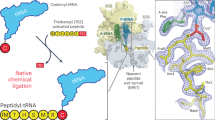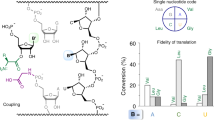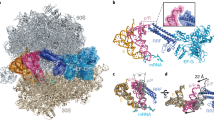Abstract
RIBOSOMES from bacterial, plant and animal cells consist of two subunits: a larger one (in E. coli the 50S subunit) and a smaller one (in E. coli the 30S subunit)1. Apparently a 30S and a 50S subunit associate to form a 70S ribosome in E. coli when the synthesis of a protein molecule is initiated; the ribosome persists during the synthesis and dissociates into subunits when the synthesis is completed2–7. There is suggestive evidence for the occurrence of the following events during the process of peptide chain initiation. First, a 30S subunit forms a complex with messenger RNA and formylmethionyl-tRNA (F-Met-tRNA) in the presence of GTP and initiation factors; subsequently, a 50S subunit is attached to this complex5–13.
This is a preview of subscription content, access via your institution
Access options
Subscribe to this journal
Receive 51 print issues and online access
$199.00 per year
only $3.90 per issue
Buy this article
- Purchase on Springer Link
- Instant access to full article PDF
Prices may be subject to local taxes which are calculated during checkout
Similar content being viewed by others
References
Attardi, G., Ann. Rev. Microbiol., 21, 383 (1967).
Mangiarotti, G., and Schlessinger, D., J. Mol. Biol., 20, 123 (1966).
Kaempfer, R. D., Meselson, M., and Raskas, H. J., J. Mol. Biol., 31, 277 (1968).
Schlessinger, D., Mangiarotti, G., and Apirion, D., Proc. US Nat. Acad. Sci., 58, 1782 (1967).
Nomura, M., and Lowry, C. V., Proc. US Nat. Acad. Sci., 58, 946 (1967).
Nomura, M., Lowry, C. V., and Guthrie, C., Proc. US Nat. Acad. Sci., 58, 1487 (1967).
Ghosh, H. P., and Khorana, H. G., Proc. US Nat. Acad. Sci., 58, 2455 (1967).
Iwasaki, K., Sabol, S., Wahba, A. J., and Ochoa, S., Arch. Biochem. Biophys., 125, 542 (1968).
Anderson, J. S., Bretscher, M. S., Clark, B. F. C., and Marcker, K. A., Nature, 215, 490 (1967).
Eisenstadt, J. M., and Brawerman, G., Proc. US Nat. Acad. Sci., 58, 1560 (1967).
Revel, M., Herzberg, M., Becarevic, A., and Gros, F., J. Mol. Biol., 33, 231 (1968).
Mukundan, M. A., Hershey, J. W. B., Dewey, K. F., and Thach, R. E., Nature, 217, 1013 (1968).
Guthrie, C., and Nomura, M., Nature, 219, 232 (1968).
Adams, J. M., and Capecchi, M. R., Proc. US Nat. Acad. Sci., 55, 147 (1966).
Nakamoto, T., and Kolakofski, D., Proc. US Nat. Acad. Sci., 55, 606 (1966).
Watanabe, M., Watanabe, H., and August, J. T., J. Mol. Biol., 33, 1 (1968).
Engelhardt, D. L., Webster, R. E., and Zinder, N. D., J. Mol. Biol., 29, 45 (1967).
Takanami, M., Yan, Y., and Jukes, T. H., J. Mol. Biol., 12, 761 (1965).
Webster, R. E., Engelhardt, D. L., and Zinder, N. D., J. Mol. Biol., 29, 27 (1967).
Pardee, A. B., Jacob, F., and Monod, J., J. Mol. Biol., 1, 165 (1959).
Parenti-Rosina, R., Eiserstadt, A., and Eisenstadt, J. M., Nature (in the press).
Eisenstadt, J., and Lengyel, P., Science, 154, 524 (1966).
Lengyel, P., in Molecular Genetics, Part II (edit. by Taylor, J. H.), 194 (Academic Press, 1967).
Jost, M., Shoemaker, N., and Noll, H., Nature, 218, 1217 (1968).
Allende, J. E., and Weissbach, H., Biochem. Biophys. Res. Commun., 28, 82 (1967).
Leder, P., and Nau, M. M., Proc. US Nat. Acad. Sci., 58, 774 (1967).
Bretscher, M. S., and Marcker, K. A., Nature, 211, 380 (1966).
Leder, P., and Bursztyn, H., Biochem. Biophys. Res. Commun., 25, 233 (1966).
Anderson, J. S., Dahlberg, J. E., Bretscher, M. S., Reed, M., and Clark, B. F. C., Nature, 216, 1072 (1967).
Monro, R. E., J. Mol. Biol., 26, 147 (1967).
Author information
Authors and Affiliations
Additional information
An erratum to this article is available at https://doi.org/10.1038/221294e0
Rights and permissions
About this article
Cite this article
KONDO, M., EGGERSTON, G., EISENSTADT, J. et al. Ribosome Formation from Subunits: Dependence on Formylmethionyl-transfer RNA in Extracts from E. coli. Nature 220, 368–371 (1968). https://doi.org/10.1038/220368a0
Received:
Published:
Issue Date:
DOI: https://doi.org/10.1038/220368a0
This article is cited by
-
Genome-wide mRNA expression analysis of peripheral blood from patients with obsessive-compulsive disorder
Scientific Reports (2018)
-
Isolation and characterisation of the φX174 ribosome binding sites
Nature (1977)
-
E. coli lactose operon ribosome binding site
Nature (1974)
-
The (Hi)Story of the induction of molecular asymmetry by the intrinsic asymmetry in β-decay
Journal of Molecular Evolution (1974)
-
RNA precursor molecules and ribonucleases in E. coli
Molecular and Cellular Biochemistry (1973)
Comments
By submitting a comment you agree to abide by our Terms and Community Guidelines. If you find something abusive or that does not comply with our terms or guidelines please flag it as inappropriate.



